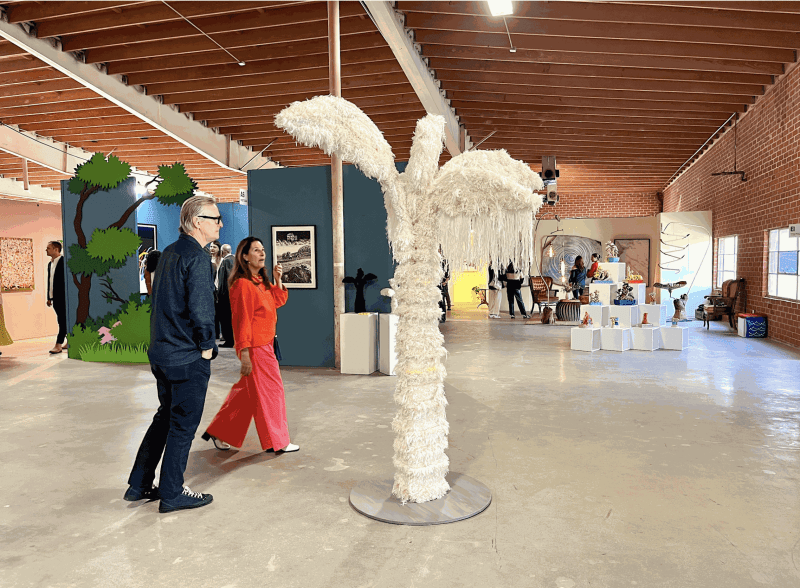LOS ANGELES — There’s a perennial booth rule at Spring/Break Art Show: “No white walls.” This directive gave the warehouse space in Culver City the aura of a migraine without the headache. I was offered a tour during the fair’s opening, but I preferred to drift and collect my little papers as I went, letting myself be drawn in by affinity and raw interest. I have a librarian friend who uses a very simple litmus for art: She either feels something or she doesn’t. I find this useful for navigating enormous rooms full of both art and art people.
Started by Andrew Gori and Ambre Kelly in 2009 in New York City as a tertiary alternative art fair, Spring/Break moved west some five years ago and is now in its fifth iteration in Los Angeles, running through this Sunday, March 3. This year’s theme of “INT/EXT” alludes to being inside but also outside, I guess? I don’t think art fairs need themes, as they tend to be incongruous smorgasbords of gallery offerings, but Spring/Break has a more elastic and less prohibitive cost-to-entry that welcomes curators, artist’s projects, and upstart galleries. And I like pondering on what out-of-towners think of California, as evidenced by the amount of car, desert, and palm tree iconography. Paintings, of course, reigned supreme, along with a few bespoke immersive installations, a handful of sculptures, and videos.
Past Nina K. Ekman’s fibrous palm trees and Nora Ann-Francis Martin-Hall’s giant hanging boat buoy rosary, I found Eric Diehl’s works at Jackson Hunt’s booth. Diehl paints mystical scenes of big desert scenes, but I favored the ones that featured wood-paneled rooms with views of lonesome places dotted across a particularly desolate and cursed section of highway between the Nevada/Arizona border. In Diehl’s world, the psychological landscape of a drifter matches the interiors of rural suburban houses, the rugged Mojave desert framed by the hard angle of a jackrabbit roof and the soft curves of an electric Prius. Restrained paintings by Anaja Hvastija Gaia, curated by Sophia Ballesteros, use the thinnest application of oil paint I’ve seen in a minute to produce an effervescent effect on otherwise simple compositions of pale, round bodies coalescing with expanses of desert. (Also giving car culture: Rachelle Anayansi Mozman Solano’s photographs of collaged Toyota trucks and Richard Zimmerman’s shattered windshield cyanotypes.)
It wasn’t just the painted walls — phosphorescent and acid-washed color palettes dominated booth displays this year, as in Philippe Hyojung Kim’s collection of obsessive and bright mold-cast bits of plastic and epoxy brought to us by The Vestibule in Seattle, Washington.
Each ceramic plate built by artist Teddy Benfield represents site-specific seafood from Long Island to Mystic Connecticut, where the artist is from. Little grabbable pink shrimps! Lemon wedges on checkered kitchen paper! World-famous oysters on the half shell next to a stubbed-out cigarette! The underbelly of each plate is painted warm neon colors that glow against Banfield’s crude pencil-drawn gridded wall like so much dry wax paper crumpled up at the end of a meal.
Speaking of cigarettes, artist and curator Thomas Martinez Pilnik, tufted a few in his double-boothed project FLUSH, produced with fellow artists Janet Loren Hill, Marianna Peragallo, and Taylor Lee Nicholson. The soft yarn of Pilnik’s giant cigarettes propped up against the wall with Peragallo’s “Amor Perfeito (Pansy)” (2022) contrasts with Nicholson’s ceramic spray cleaning bottle labeled “The best thing about DIVORCE is no longer cleaning up after a grown man and the puddle of piss pooling at the foot of the toiler.” (Never again!!! Congrats to Nicholson!!!)
The stars of the fair for me were paintings by Andrea Castillo — an artist with zero web presence, which for an arts journalist is inconvenient but thrilling — and the video work of Sabrina Ratté, in which a gelatinous pearlescent pink recliner chair is subsumed slowly, lugubriously, by enchanted, psychedelic fungi. I crouched, mesmerized, locked into pose while I watched; the provided chair was too far away from the screen and I couldn’t tell if it was art or not anyway. (Local tip: Ratté also has video work installed at the Central Public Library downtown.)
True to Spring/Break’s less-glossy nature, electrical wires draped over booths painted the colors of notebook paper yellow and lilac, while exposed pine wood and a few brick walls accentuated some otherwise pretty Burner-ish aesthetics. But more importantly, emerging artists, curators, and lesser-known galleries get space to show and connect. As a friend working Felix put it over DM: “It’s the usual suspects here,” but at Spring/Break everyone’s pretty new and that energy, in this era, can only be refreshing.

